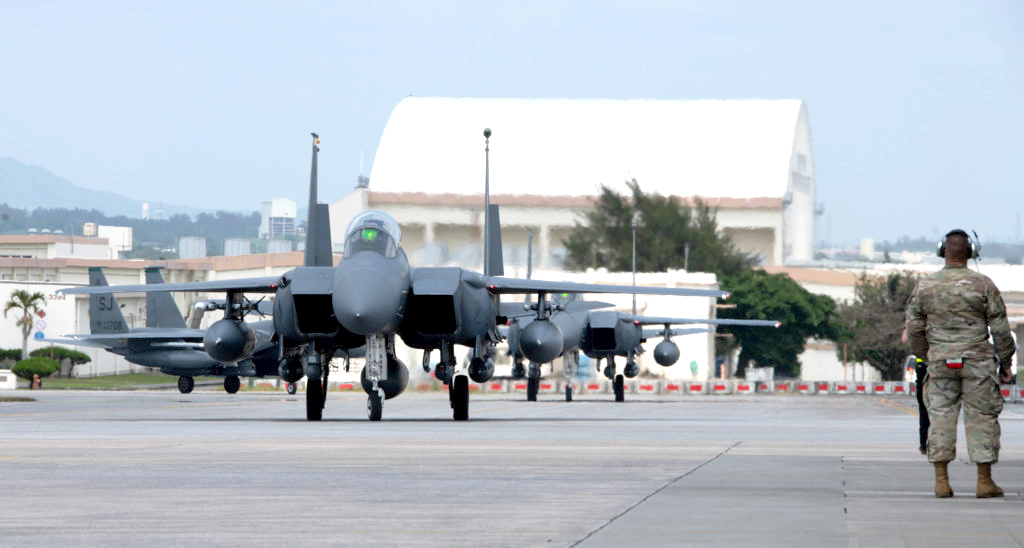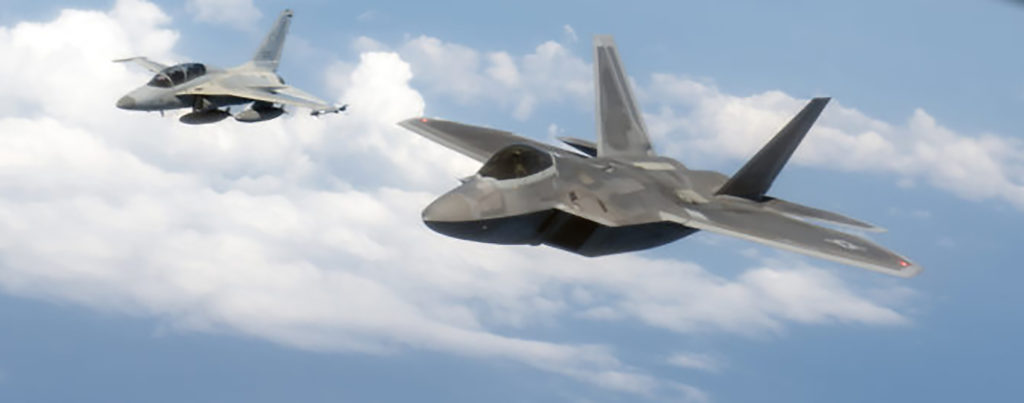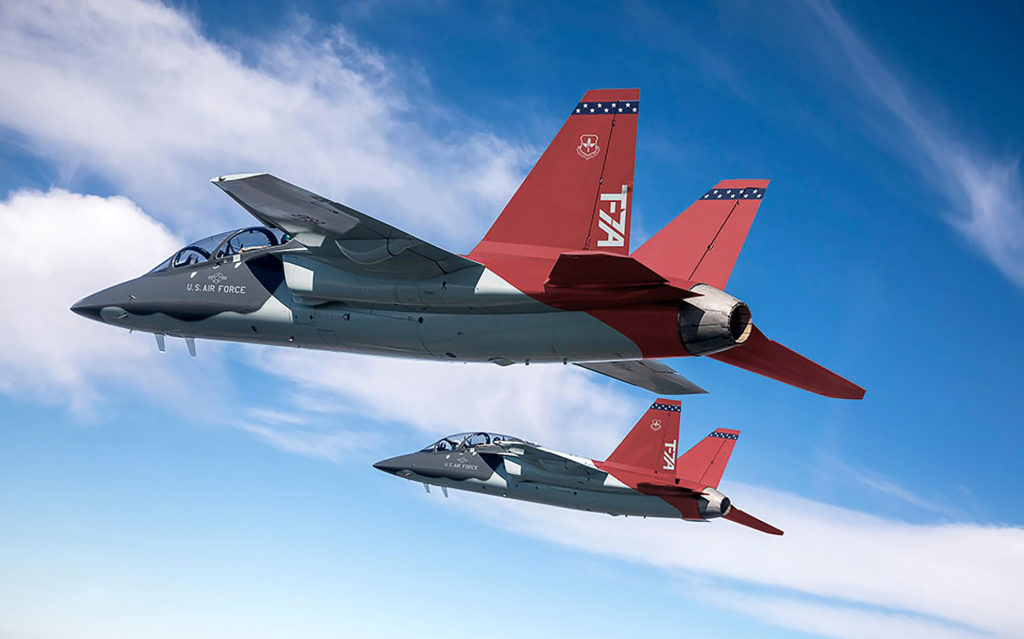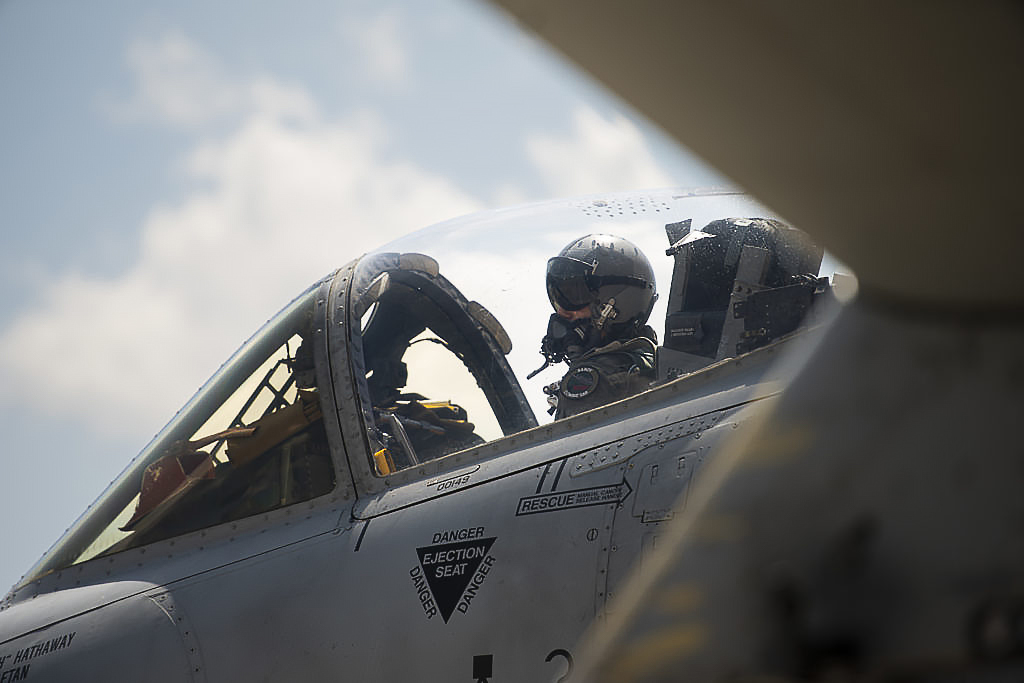USAF’s Fighter Mix Keeps Changing at Kadena
By Chris Gordon
F
-15E Strike Eagles deployed to Kadena Air Base, Japan, in April, joining F-35s to bolster the Air Force’s fighter fleet on the strategically important island in the western Pacific. At the same time, the F-16CMs and F-22s previously deployed there returned home.
The Air Force is rotating fighters through Kadena as worn-out F-15C/Ds return back to the United States after more than 40 years of permanent Eagle operations there. The Air Force has had every active type of fighter aircraft cycle through Kadena in the past five months, with the exception of the A-10. Otherwise, F-15C/Ds, F-15Es, F-16s, F-22s, and F-35s have all operated there.
“Modernizing capabilities in the Indo-Pacific theater remains a top priority,” Kadena Air Base’s 18th Wing stated in a news release. “This reception of advanced fighter aircraft at Kadena ensures the 18th Wing remains postured to deliver lethal and credible airpower to ensure the defense of U.S. allies and a free and open Indo-Pacific.”
F-15Es from the 336th Fighter Squadron at Seymour Johnson Air Force Base, N.C., touched down in Okinawa in April, just as F-22s Raptors and Airmen from the 525th Fighter Squadron headed home to Joint Base Elmendorf-Richardson, Alaska. Two days later F-16CMs from the 480th Fighter Squadron returned to Spangdahlem Air Base, Germany.
Kadena’s two-squadrons of F-15C/Ds were 48 strong until the Air Force started sending those aircraft stateside. The best of those aircraft will be transferred to Air National Guard units, while the bulk are headed for the Boneyard at Davis-Monthan Air Force Base, Ariz.
The need to rotate forces through Kadena is an indication of the challenges faced by today’s smaller Air Force. The Alaskan F-22s were the first new rotational unit deployed to the key southern Japanese island, which is the closest U.S. air base to Taiwan—450 miles away. F-16CMs from Germany later joined the Raptors in January.
Now the mix is F-35s and F-15Es.
“The F-15E is a proven combat platform that brings some unique capabilities into our already formidable mix of aircraft here at Kadena,” said Col. Henry Schantz, 18th Operations Group commander, in a news release.
The F-22s had an eventful deployment to the western Pacific, becoming the first fifth-generation fighters to deploy to Tinian and the Philippines. JBER said the aircraft flew 1,100 sorties during their four-plus month deployment. The F-16s stayed around three months and their deployment generated fewer headlines. The deployment of F-15Es and F-35s—along with the remaining F-15C/Ds—ensures Kadena will have a mix of fourth- and fifth-generation aircraft for now.
USAF Plans $9 Billion in F-22 Updates
By John A. Tirpak
E
nsuring the F-22 Raptor’s ability to prevail in combat for another eight years will cost more than $9 billion, even assuming the oldest 32 Raptors are retired next year.
But if Congress balks at the retirements, as it did a year ago, the Air Force may not be able to keep its Next-Generation Air Dominance program on schedule, senior officials said.
“Our budget assumes the success of that proposal,” Air Force acquisition executive Andrew Hunter told the House Armed Services tactical aviation subcommittee March 29.
The Air Force’s fiscal 2024-2028 spending plan includes $4.2 billion in procurement for F-22 upgrades—plus another $1.74 billion “to completion” circa 2030 and $3.2 billion in research, development, test, and evaluation funds. That’s a total of $9.06 billion, and doesn’t count operations and maintenance.
“Sensor enhancement” amounts to $4.13 billion of those funds, with reliability and maintainability upgrades adding another $2.43 billion. Other improvements are for Link 16 modifications; identification/friend or foe systems; trainer and simulator modifications; anti-jam/anti-spoofing and position, navigation, and timing work; and modifications to the F-22’s Pratt & Whitney F119 engines.
The Air Force also wants to spend $553 million on stealthy long-range fuel tanks and pylons, enough to give each aircraft at least two full sets of each. The F-22 can fly at speeds up to Mach 1.2 with the tanks and pylons, budget documents say.
The tanks and pylons, as well as stealthy-looking pods with an apparent dielectric front-end aperture, have been seen in flight-test photos of F-22s captured around Lockheed’s Palmdale, Calif., facilities. They were also shown in an artist’s concept released by Air Combat Command last year, without an explanation of what the underwing stores are.
Aviation experts speculate that the slender pods contain infrared search-and-track systems (IRST) and may have other sensors, as well. A former Lockheed program official has previously told Air & Space Forces Magazine that there is insufficient “real estate” within the F-22’s fuselage to host an IRST, an alternative method of detecting an adversary aircraft built with low radar cross section, like China’s J-20 fighter.
USAF spending plans currently call for investing at least $1 billion a year in fiscal 2026 and 2027 in the F-22, before dropping off sharply in 2028 to $426.8 billion. RDT&E investment would end in 2028.
Counting previous spending going back to fiscal 2018, the Air Force is projecting the total cost of keeping the F-22 capable against current and future threats at $16.2 billion, according to an Air Force spokesperson. That comes to more than $100 million for each of the 148 or so F-22s the Air Force plans to retain.
The jets the Air Force wants to divest have been used for basic skills training and not been kept to the same configuration as the front-line fleet. Air Force Secretary Frank Kendall has said he estimates it would cost $50 million apiece to upgrade them to the current operational fleet configuration, and considerably more to keep them consistent with the rest of the fleet on top of the cost of flying and maintaining them.
The Air Force asked Congress last year to retire the same 32 F-22s but was rebuffed. It’s asking again this year not only because those aircraft are “no longer operationally representative,” but the cost to bring them up to full capability would be “prohibitive,” Lt. Gen. Richard G. Moore, deputy chief of staff for plans and programs, told the HASC tactical aviation panel. They are also no longer competitive with China’s best stealth fighters, he said.
“Upgrading the Block 20s to a combat configuration is cost-prohibitive and very time intensive,” Moore testified. “Based on the most advanced weapons that an F-22 Block 20 can carry now, it is not competitive with the [Shenyang] J-20, with the most advanced weapons the Chinese can put on it.”
Neither the F-22 nor NGAD accounts include funding for the AIM-260 Joint Advanced Tactical Missile, which is to be their primary weapon.
Collaborative Drones Will Arrive Before NGAD
By John A. Tirpak
The first iterations of Collaborative Combat Aircraft (CCAs), the drones the Air Force hopes to pair with manned fighters, will join the Air Force’s fighter fleet in “the later 2020s,” several years before the Next-Generation Air Dominance fighter, said service acquisition chief Andrew Hunter.
Hunter told the House Armed Services tactical aviation subcommittee that CCAs will augment all types of tactical aircraft, not just NGAD.
Lt. Gen. Richard G. Moore Jr., deputy chief of staff for plans and programs, said the top three missions for CCAs will be as:
- Shooters
- Electronic warfare platforms
- Sensor aircraft.
Hunter said NGAD and CCAs are “on different timelines,” but “obviously closely related to one another as part of a family of systems.” NGAD is a “very high-end capability,” he said, geared to the threat environment of the 2030s, and “we are working very hard to deliver [it] … in the early 2030s.” CCAs could join the force later this decade, he added, with a notional target of between 1,000 and 1,500 of the uncrewed aircraft.
Though uncrewed, the new aircraft will still be pricey. Air Force Secretary Frank Kendall testified CCAs could cost between a quarter and half as much as an F-35, putting them in a range between $20 million and $41 million.
Hunter said the Air Force is “very much focused on speed-to-ramp,” and that the service will prioritize contractors’ ability to “perform as quickly as possible” in evaluating proposals.
Moore said CCAs will help to more affordably build up the Air Force’s combat air forces, enabling the “amount of iron that needs to be in the air to confront an adversary like China.”
“The way that we can do that affordably is by buying CCAs, and by creating mass with CCAs,” he said.
Still unclear are the tactics, techniques, and procedures for such weapons and the organizational structures, such as whether CCAs will belong to conventional fighter squadrons or “a separate entity” or whether they will fly alongside crewed aircraft or “come together on the battlefield” from different places.
The 2024 budget includes a request to create an experimental operations squadron to explore such questions, Moore said. Asked what the CCAs will be counted on most to do, Moore laid out three basic mission sets.
Pressed by lawmakers as to whether the Air Force needs seven additional fighter squadrons, as the service stated in its 2018 “The Force We Need” white paper, Moore said the answer depends on the success of the CCA concept.
“Capacity is an issue and the mass that it takes to confront an adversary like China is intense,” Moore said.
It’s Official: Re-Engined B-52 Will be the B-52J
By John A. Tirpak
New re-engined B-52 bombers will be designated the B-52J, according to the Air Force’s fiscal 2024 budget documents, resolving a debate over the future nomenclature as the bomber gets some of the most significant improvements in the H model’s 61-year service life.
“Any B-52H aircraft modified with the new commercial engines and associated subsystems are designated as B-52J,” the Air Force said in justification documents for its 2024 budget request.
The Air Force is asking for nearly $3 billion in B-52 procurement over the five-year future years defense plan (FYDP), starting with $65.82 million in 2024 and ramping up to over $1.1 billion annually in 2027 and 2028. The program seeks to replace the original Pratt & Whitney TF33 engines with Rolls-Royce F130s on 76 B-52s and is expected to pay for itself through 30 percent better fuel efficiency and the elimination of future engine overhauls over the life of the program.
A Radar Modernization Program will likewise upgrade all the radars, including 74 radar kits, three training systems kits, and two engineering and manufacturing development kits, at a total cost of $845.9 million over the FYDP. Additional research, development, test, and evaluation funding for the Radar Modernization Program adds another $371 million from 2024-2026.
The new radar is a variant of the Raytheon AN/APG-79, an active, electronically scanned array (AESA) radar used on the Navy’s F/A-18 Super Hornet fighter. It replaces the APQ-166, which the Air Force says suffers from severe “vanishing vendor” issues and parts problems that will make the radar “unsupportable” before 2030.
Besides a dramatic improvement in maintainability, the AESA will add significant new capabilities in search, ground mapping, and electronic warfare. The new radar’s physical footprint is also much smaller than the system it replaces, creating growth capacity in the front of the aircraft. The B-52’s nose-mounted electro-optical blisters will be removed and a new radome installed with the new radar.
T-7 Trainer Production Delayed to 2025
By John A. Tirpak
The Boeing T-7 Red Hawk advanced trainer won’t be ready for a low-rate initial production decision until February 2025—six and a half years after Boeing won the initial contract in 2018.
The new date for the “Milestone C” initial production decision is as much as 14 months later than was anticipated as recently as late 2022, caused in part by concerns over the safety of ejection seats. Those and other issues are now or will soon be resolved, the Air Force said.
The first production aircraft will not be delivered until December 2025 at the earliest, USAF said. It is not clear how much the delays will push back initial operational capability (IOC), which was originally scheduled for 2024 and had more recently been promised for 2026.
Regardless, the ripple effect of T-7 delays could force the Air Force to invest in further life extensions for its 60-year-old T-38 trainers, which the T-7 is supposed to replace. The Air Force continues to fund Pacer Classic III structural modifications for the aircraft, along with avionics upgrades, to the tune of $125.3 million in FY24.
The Air Force plans to buy at least 351 T-7A Red Hawks and 46 high-fidelity simulators. USAF’s new “Reforge” fighter pilot training plan could increase that total. Boeing’s contract provides for up to 475 aircraft.
The Air Force and Boeing “are confident improvements and recent testing are yielding a safe and effective escape system” for the T-7, a service spokesperson said.
Last year’s planning documents showed the service spending $321 million on T-7 production in fiscal 2024, but USAF zeroed-out T-7 production funding for fiscal 2024 in its recent budget request.
“Milestone C has moved to February 2025,” so procurement funding “for Low-Rate Initial Production is not needed in FY24,” the spokesperson said. At Milestone C, the undersecretary of defense for acquisition and sustainment decides if a program has met its exit criteria from engineering and manufacturing development (EMD) and is ready for production.
A principal cause of delay were concerns noted across more than a dozen ejection seat tests. Air Force officials have said that tests showed Boeing’s escape system exhibiting unsafe deceleration at parachute opening, potentially causing pilots’ to suffer concussions as their visors tore off. Industry sources suggest, however, that USAF’s crash dummies were improperly instrumented, suggesting inaccurate results. The sources said USAF is revisiting some of those data.
Under the initial 2018 contract, Boeing was to have delivered the first five production aircraft in 2023. Most of those are now complete, but developmental flight-testing has been held up by the seat issue and is now anticipated to start in September, the Air Force spokesperson said. Boeing said last week that it expected developmental testing to start “this summer.”
Boeing ran into problems with the seats last year when they didn’t function as expected with pilots at the smallest and lightest end of the range. The T-7 is the first USAF aircraft to be designed from the outset to accommodate pilots in a wide variety of physical sizes. Ejection systems on previous trainers and fighter aircraft could accommodate only a narrow range of physiques and excluded too many potential student pilots, particularly small women.
Air Force acquisition executive Andrew Hunter said in March budget testimony that recent sled tests with the seats have given confidence that the ejection problems are on the mend.
“Minor changes to seat logic” have “already reduced system risk and increased pilot safety,” the spokesperson explained. Additionally, “the USAF and Boeing are studying the ejection seat performance throughout 2023 to identify additional enhancements, and Boeing will use the results of testing to inform changes needed to qualify the seat as safe for production.”
Supply chain issues have also contributed to T-7 delays, the Air Force said.
“Prior to the FY23 President’s Budget,” the Air Force and Boeing “recognized schedule impact to the T-7A ‘Red Hawk’ program partially attributable to developmental discovery and the COVID-19 global pandemic,” the USAF spokesperson said.
In June 2022, USAF and Boeing “began a schedule re-baseline effort to assess the collective impacts of all schedule delays to date, to include … ground [testing], preflight testing and hardware qualification challenges; contractor inability to rapidly correct deficiencies; subcontractor initial design delays; three aerodynamic instability discoveries; escape system qualification delays; and supplier critical parts shortages,” the spokesperson explained.
After an “exhaustive” schedule risk assessment, “the T-7 program office recommended a new [Milestone C] date of February 2025 and is awaiting final coordination of this change,” the spokesperson said.
The Air Force does not plan to accelerate testing to gain back lost time. The Air Force and Boeing “do not believe the delays can be overcome by more aggressive flight tests,” the spokesperson said. The planned flight-test schedule “is already success-based and aggressive.”
Boeing has been flying its first two T-7s—“T1” and “T2,” which the Air Force refers to as “production relevant”—at the company’s St. Louis facilities, but Air Force pilots are not permitted to fly the pre-EMD jets for testing purposes until the seat and other issues have been resolved.
The first three EMD examples of the T-7 are complete and two further aircraft are in the final stages of construction, USAF said. These five jets “will be enough for flight-testing.”
A-10s, E-3s Head to the Boneyard
By Chris Gordon and Greg Hadley
After years of pushing to retire A-10s and E-3s, the Air Force began divestments in earnest in April, retiring the first of 21 A-10s and the first of 13 E-3 AWACS planes.
An A-10 Thunderbolt II from the 74th Fighter Squadron at Moody Air Force Base, Ga., arrived at the Boneyard at Davis-Monthan Air Force Base, Ariz., on April 5, the service said. Some 20 more Warthogs will leave service by the end of September.
“Air Combat Command is prioritizing the A-10s with the least combat effectiveness for retirement first to ensure the most combat-capable airframes remain in service,” the Air Force said in a news release. Those aircraft will come from multiple bases.
The Air Force has sought to retire some of the close air support aircraft for years but was blocked by Congress until the 2023 National Defense Authorization Act OK’d this divestiture. The service plans to retire another 42 A-10s if Congress approves the move with the 2024 budget. Air Force Chief of Staff Gen. Charles Q. Brown Jr. has said the service wants to rid itself of the A-10 entirely by the end of the decade.
E-3 Tail Number 0560 departed Tinker Air Force Base, Okla., for its trip to the Boneyard at Davis-Monthan April 6, a week after the 552nd Air Control Wing hosted a retirement celebration where retired and Active-duty Airmen signed their names to the airframe, an Air Force tradition.
“It means a new way is coming, but it’s still sad because we have a lot of great memories,” one former Airman told local television station KOLO. “We had a great mission back 20, 25 years ago.”
With the retirement, the Air Force’s AWACS fleet shrunk to 30 aircraft, on its way to under 18. Based on the commercially defunct 707 airframe, E-3s are expensive to maintain, their mission-capable rates plunging below 65 percent in recent years. Air Combat Command boss Gen. Mark D. Kelly called the E-3s “unsustainable without a Herculean effort” last year, praising “miracle worker” maintainers for getting the aircraft to fly at all. Averaging over 40 years old, the AWACS fleet is among the oldest in the Air Force.
USAF will replace the AWACS with the E-7 Wedgetail.
Aircraft at the Boneyard are preserved in the dry desert of Arizona and often cannibalized for parts. The A-10 that landed Davis-Monthan on April 5, tail number 80-149, is now in the hands of 309th Aerospace Maintenance and Regeneration Squadron, which will “get to work preserving as much of it as possible while removing parts that can be used for replacements in other A-10s,” the Air Force said.
The Air Force’s planned divesture of 21 A-10s in the fiscal year 2023 will leave the service with around 260 aircraft by September. Brown said the service is ditching its 4+1 fighter model—with the A-10 as the outlier—and plans to sunset all A-10s by 2029.
“We’re retiring A-10s faster than we originally thought,” Brown said at the annual McAleese defense conference March 15. “I think that’s probably the right answer.”
But in the near-term, concerns over capacity have led to high-profile A-10 deployments. While the Air Force argues that the four-decade-old A-10s—which have been upgraded over the years—are not survivable against an advanced adversary, U.S. Central Command is using them to fill out its fighter squadron requirements in the Middle East.
A planned deployment of A-10s to CENTCOM was accelerated in the wake of attacks from Iranian-backed militias on U.S. bases in Syria. The command produced a slick video noting their arrival at the end of March and has continued to publicize recent A-10 operations in the region.
“The A-10s remain the most effective close air support platform in the world today even after 45 years,” Capt. Kevin Domingue, the pilot from the 74th Fighter Squadron who flew the now-retired A-10 to the Boneyard, said in the news release. “As long as the Air Force allows the aircraft to fly and be properly maintained, this community is ready to provide that expertise anywhere in the world against any adversary.”




